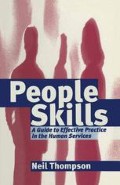Abstract
This is the first of three chapters that address communication, a central feature of interaction. The major focus is on the spoken word, although account is also taken of the wider context that affects and influences the process of verbal communication.
Preview
Unable to display preview. Download preview PDF.
Further reading
Burnard, P. (1992) Communicate!, London, Edward Arnold.
Hargie, O. (1986) A Handbook of Communication Skills, London, Routledge.
Hargie, O. Saunders, C. and Dickson, D. (1994) Social Skills in Interpersonal Communication, London, Routledge.
Hartley, P. (1993) Interpersonal Communication, London, Routledge.
Hinton, PR. (1993) The Psychology of Interpersonal Perception, London, Routledge.
Lishman, J. (1994) Communication, London, Macmillan.
Little, P. (1995) ‘Records and Record-Keeping’, in Carter, P., Jeffs, T. and Smith, M.K. (eds) Social Working, London, Macmillan.
Pugh, R.G. (1996) Effective Language for Health and Social Work: Closing the Gap, London, Chapman and Hall.
Editor information
Copyright information
© 1996 Neil Thompson
About this chapter
Cite this chapter
Thompson, N., Campling, J. (1996). Verbal communication. In: Campling, J. (eds) People Skills. Palgrave, London. https://doi.org/10.1007/978-1-349-13737-4_9
Download citation
DOI: https://doi.org/10.1007/978-1-349-13737-4_9
Publisher Name: Palgrave, London
Print ISBN: 978-0-333-63721-0
Online ISBN: 978-1-349-13737-4
eBook Packages: Palgrave Social & Cultural Studies CollectionSocial Sciences (R0)

